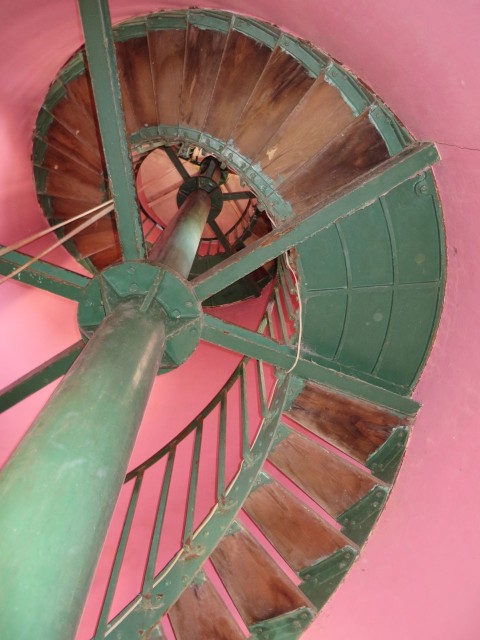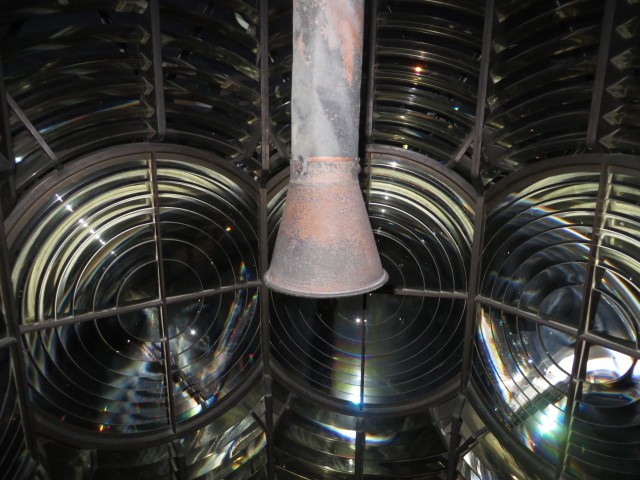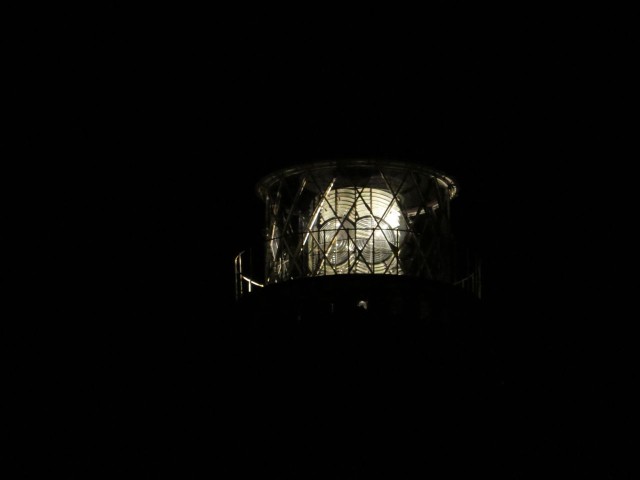WARNING – This is a long blog post! We had an amazing experience. I don’t ever want to forget this.
The Elbow Reef Lighthouse was our first sight of Hope Town on December 12th when we finally ended our first 3 months of traveling down the East Coast and across the Gulf Stream. The only way to enter Hope Town harbor, as a “deep draft” boat, is to aim directly at the lighthouse as though you were going to run right up onto land. Then you must make a sudden left turn and follow the shore, curving right, into the marked harbor channel. It is a bit unnerving the first time, but we have come in and out so often that it is no big deal now.
The lighthouse has greeted us every morning since then and watched over us every night as we gently swing on our mooring in the harbor. As a part of our daily surroundings, it has fascinated and intrigued me for weeks.
The Elbow Reef Lighthouse is considered to be “iconic” as it is the most recognizable of the eleven Bahamian lighthouses. Its official name is the Elbow Reef Lighthouse, but most people call it the Hope Town Lighthouse. Shipwrecks were very common in the seas around the Abacos because of the shallow waters and reefs. In 1863 England decided to build a lighthouse at Hope Town to warn ships away from the extensive Elbow Reef, where wrecks occurred once each month, on average. At that time, the people of Hope Town were not pleased to receive a lighthouse because salvaging the wrecked ships (called “wracking” ) was a profitable enterprise for them.

A picture book, titled “The Candy Striped Lighthouse” was just published in December and tells the story of the lighthouse through a poem by Elizabeth Webb with art by Bruce Johnson. It also includes some history of the Bahamas, The Elbow Reef Lighthouse, and Hope Town. The first two verses:
The Candy Striped Lighthouse I stand on a hill
Watching over the world down below.
I gaze out to sea and around Elbow Cay
And the boats as they pass to and fro.
I bid them goodbye and examine the sky
For changes of wind and of tide;
Look smilingly down on the candy bright town
And Hope Town looks upward with pride.
Last week the Elbow Reef Lighthouse Preservation Society hosted a presentation by Cullen Chambers, Executive Director of the Tybee Island Historical Society, on the “Challenges and Rewards of Restoring Historic Lighthouses.” Cullen Chambers and his team were here to perform the first in-depth survey of the lighthouse in 50 years. Hope Town is trying to preserve this very special lighthouse while maintaining its charm and unique significance for future generations. This is no simple task since there are numerous repairs and maintenance projects that are needed, e.g. repairs to the lantern room door, windows and shutters, the apron, the slate floor in the tower. Not to mention the challenge of securing parts for the older kerosene light equipment. The Elbow Reef Lighthouse Preservation Society is “committed to historically correct restoration and maintenance of the old hand-wound and kerosene-burning technology and the unique keeper’s dwellings. The value as symbols of our national maritime heritage and as a tourist attraction cannot be overstated.”

Since I posted this blog entry last night, we have heard the sad news that Cullen Chambers passed away unexpectedly earlier this week.
Finally, on January 19, 2014, we had a good day to climb to the top of the lighthouse. It was a sunny, cool, and dry Sunday morning, perfect for this adventure!
Let me take you with us as we visited the lighthouse and climbed to the top. No guards, no fee, almost no rules. Just wander up and take a look!


And then we were outside with a 360 degree panoramic view!


That adventure was on Sunday, but there is more! We had heard it was possible to watch the light keeper on duty in this very special and unique lighthouse, the only remaining hand-wound kerosene burning lighthouse left in the world. What does that mean in this day of automation? It means that nowhere else could we ever have the experience we had on this evening here in Hope Town.
On Monday, late afternoon, just before sunset, we dinghied back to the lighthouse and sat on the step to wait for the light keeper.
Jeffrey Forbes, Jr. is the keeper of the Elbow Reef Lighthouse. He is a second generation light keeper who is carrying on the tradition he learned from his father, Jeffrey Forbes Sr., a Bahamian lightkeeper for 37 years before he retired. Jeffrey, Jr. graciously allowed us to tag along as he worked. He is quiet and reserved, but readily answered our questions. Jeffrey has been keeping the light burning without assistance since September when the other keeper left on sick leave. It was obvious to us that he loves this”job” of caring for the lighthouse.

While Jeffrey pressurized the tanks, we stepped outside to view the sunset.
We never imagined that we would be able to be right there in the lantern room, next to the fresnel lens! We climbed up a small steep ladder and were right beside the fresnel lens. Jeffrey’s next step was to drop the fabric curtain that surrounds the lens. This curtain is in place and covers the lens throughout the day. Without the cover, the lens could act as a giant magnifying glass and start a fire.
Once lit, the light is focused as it passes through the optics of a “first order, eight thousand pound Fresnel lens”. Fresnel lenses came in different sizes, called “orders”, ranging from (smallest) to the largest, the First Order lens. The lens floats on a bed of mercury, reducing friction as it turns around all night to shine its light out onto the sea.
Jeffrey’s work was not done. In fact, his work continues throughout the night. Every two hours, Jeffrey has to wind, to the top of the tower, seven hundred pounds of weights using a hand winch. The descending weights, through a series of bronze gears, rotate the four-ton apparatus once around every 15 seconds.

The nautical charts describe its sequence as, “GP FL W(5) EV 15 SEC 120 FT 15M.” – a series of five white flashes every fifteen seconds at 120 feet above sea level, visible for 15 nautical miles.
As we walked down the path to the dock, we looked back at the light. We see it through new eyes, appreciating the historical significance as well as the commitment of the light keeper and the people of Hope Town who wish to preserve this special place.
“The smooth sweep of the turning lenses with their five swords of light cutting the darkness over the sea while the light constantly glows between those beams is known as the “soul” of a lighthouse. Once seen and compared to an electric flashing light, it is not soon forgotten and the use of the word “soul” is more easily understood.” ~ David Gale,
Founder and President of the Bahamas Lighthouse Preservation Society.

































LeRoy Hornack
We visited anchored out In Hope Town many times when cruising the Abacos.
Now that we have ‘swallowed the anchor’, we are collecting lighthouses of the Bahamas.
To date we have been unable to find a desk top model of the Elbow Cay candy-striped light House.
Would truly appreciate any assistance you may offer in our quest.
LeRoy Hornack
St. Joseph, MI
USA
The Lighthouse | Kindred Spirit
[…] Visiting this lighthouse was probably the most memorable experience of our time in the Abacos on our first trip. I wrote a detailed blog post then so that I would never forget this unique experience; especially the evening we joined Jeffrey, the lighthouse keeper, for the lighting of the lantern. What a special experience that was – “Candy-Striped Lighthouse.” […]
2014-03-15 Abacos Part II – Lighthouse – Friends – Universe | S/V Magnolia
[…] I intended to write about the VERY unique Hope Town lighthouse, but I cannot do the subject justice so I am going to ask you take a moment and read Michele’s description and history of this unique place. (Elbow Reef Lighthouse – “The Candy Striped Lighthouse”) […]
Anthony Baker
Michele thank you for a most amazing story. We look forward to visiting Hopetown in a all new light. Know that when we do, I will be remembering this post. Thank you